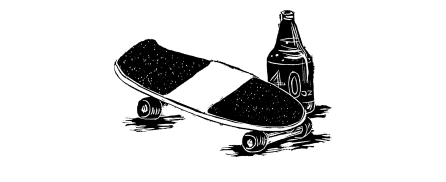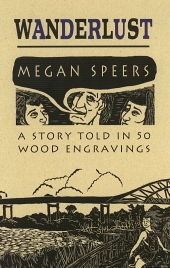The Porcupine's Quill
Celebrating forty years on the Main Street
of Erin Village, Wellington County
BOOKS IN PRINT
Wanderlust by Megan Speers
A wilful young woman revels in the surprisingly-inclusive communal aspects of life in the punk / anarchist counterculture as it was practised in the hardscrabble underbelly of Sault Ste Marie on the cusp of the 21st century.

In Wanderlust, Megan Speers introduces us to an unlikely heroine who embraces a decidedly perilous but fiercely-independent life among the punks of the third-largest city in northwestern Ontario in the mid-1990s.
Proponents of similar subcultures typically self-identify in any community, so these fifty panels of images could just as accurately represent events in any small city in almost any country in the world in the thirty years since the advent of the Clash, Johnny Rotten, Sid Vicious and the Sex Pistols. The images are wood engravings, carved on blocks made ‘by scratch’ (as it were, in the true spirit of the Do It Yourself ethos) by the artist and her family. The images themselves are then scratched into the surface of the wood, depicting the mostly happy lives that the punks eke out for themselves in the discarded backwater of the Sault that no-one else wants or needs to frequent.
Bush parties on Whitefish Island, dumpster diving for pizza and the anarchist aesthetic, all rendered in the sort of bold, crisp lines reminiscent of Frans Masereel’s 1919 classic graphic novel Passionate Journey which depicts a not dis-similar idealistic individual’s struggle with destiny and fate in a life that has known its joys, its illusions and its disappointments.

2011—ForeWord Magazine Book of the Year,
Shortlisted
Review text
With Wanderlust, the masters in art book production at Porcupine’s Quill have trained a spotlight on another talented craftsperson. In this third in their series of wordless novels edited by the notable George A. Walker, award-winning printmaker Megan Speers combines talent in both carving and storytelling to create an optimistic and enjoyable book.
A wordless novel, told in pictures, necessitates that its readers tell the story to themselves; what follows both hews to and creates anew an oral tradition. A certain universal accessibility is produced as Speers allows a simple tale to speak for itself through symbols, interpreted in the language and experience of the reader (and perhaps, even the woodcuts themselves could serve as a tangible document for those to whom images are not accessible). Here, even dialogue balloons themselves contain images, and an interesting mise en abime effect is produced.
The degrees of detail and texture betray an enormouse amount of work and care taken in producing the series of fifty woodcuts that narrate this piece. It’s interesting to note that Speers would spend such time working (presumably) in one place in order to depict a tale about motion: it seems to be a subject close to the artist’s heart. The archetypal nature of the story, which includes various small town punk life landmarks (e.g., being broke, dumster diving, and enjoying time spent with friends) is rendered in a medium that reads as permanent, the deep black ink serving to solidify the images.
Relating such varied experiences as targeting and brutality at the hands of police, or cruising on a skateboard down an open path on a breezy, sunny day, Speers explores both the light and dark sides of life. Still, these panels depict some of the happiest moments of camaraderie in the pitch of night, and in so doing break down that very binary.
Speers’s style is clearly influenced by contemporary graphic art and animation, and includes a variety of frame/cell sizes, creative use of depth of field, and is filled with emotional resonance. It would fit in well next to Liz Baillie’s My Brain Hurts on the bookshelf of anyone who identifies with newfound joy in autonomy -- particularly those who appreciate the prototypical black and white punk aesthetic. Each of these woodcuts is a singular work of art, and Wanderlust is a very pleasing read.
—Patty Comeau, ForeWord Reviews
Review quote
‘A wordless novel in the tradition on Lynd Ward, Frans Masereel, & co., Wanderlust follows a teenage girl’s punk life-style through the summer days of booze, bands, boys and the occasional bit of dumpster diving. A well laid out visual tale leaving the reader with a number of memorable engravings of anarchy and bliss.’
—Bytown Bookshop
Review quote
‘Wanderlust unites book nerds and punking adolscents alike. Told without text, through 50 unimaginably labour-intensive, hand-carved Canadian maple wood engravings, Wanderlust depicts a night out on the town in Sault Ste. Marie with a dumpster-diving teen. Megan Speers’ setting down of the story contradicts the impermanence of youth and of the ‘Packsack People,’ for whom the book is dedicated. It’s this juxtaposition, ‘visualizing a time and place that is not long on recorded history’ as it’s put in the foreword, that elevates this simple story for reflection and careful interpretation.’
—Salon
Review quote
‘With each wood engraving Speers creates images that are arrestingly simple but at the same time astonishing with the way they capture conversations, movement and detail. With one image on each page, Wanderlust invites you to think about each impression on its own in addition to how it fits into the overall puzzle of the author’s story and life.’
—Shannon D’Arcy, Shameless Magazine
Author comments
In my head, Wanderlust is a graphic novel told in fifty images that have organized themselves into seven ‘chapters’, to use the word loosely, each of which is preceded by a blank page and ends with a distinctive wood block that is either smaller than typical, with rounded edges, or else oversized and panoramic. Some chapters are as brief as five images, others are longer.
The first chapter contrasts the tedium of working a bummer/dead end job, and then changing into gear for fun, and skating (skateboarding, of course) to a friend’s place close by. The population of Sault Ste Marie at this time was about 80,000. Nothing was very far from anything else; from the downtown, the river or the bridge to Michigan. The heroine works in the rag trade at a seamstress’ shop doing alterations. At the end of each shift she changes into her regalia of choice and skates a few blocks to a friend’s house.
In the second chapter, the reader sees her socializing with a much older male character who is loosely based on an octogenarian acquaintance of the author’s father who lived in the Sault whose name was Arnold. This was a big part of adolescence in the early 1990s in a small city in northwestern Ontario, where punks frequently sought out older folks to listen to stories about their lives. Arnold had lived in Germany prior to and during the first part of World War II. He could tell war stories for hours and expound on his crazy theories about all kinds of things, like the barrage balloons that were set in the early 1940s to defend the Straits of Mackinac from the threat of Messerschmitts. As if that were likely, or even possible!
In the next section, the two main characters skate off together to another friend’s place, which is a local hangout where punks gather on a back stoop to play music and drink beer. The characters in the images are all customarily broke, either because they have had difficulty finding work or simply because they do not really want to sew hemlines when they are able to get along nicely enough without. Some are anarchists and steadfastedly opposed to the idea of centering their lives around some creed they don’t share. The group goes through this regular routine of gathering together and pitching in whatever cash is available to get beer. Sometimes a few of the characters have no money at all to contribute but yet there always seems to be enough to go around. The life is seen to be very communal. There is definitely an underlying expectation that the group should always be able to entertain themselves as an inclusive group regardless of income or lack thereof. Music is central to the experience as well; again, regardless of talent. Even someone who is not particularly adept at an instrument will still be invited to jam with the better musicians. There is a lot of skill sharing depicted in the images, again very communal.
In the fourth chapter the two main characters venture off on their own, in search of snacks. Mrs. B’s is a real place on East Street in the Sault, the kind of ubiquitous pizza joint in the downtown core that everyone knows. The characters in Wanderlust favour Mrs B’s because of the possibility that overstock at the end of the night will be distributed free in return for the odd bought slice. The management is known, as well, to throw out full pizzas on occasion and to leave the discards in their original boxes on top of the rest of the trash so the dumpster diving doesn’t become unnecessarily gross. Discarded, unadulterated, pizzas do not happen frequently on East Street, but when they do it is like the northern lights have just emerged from a steaming carton of double pepperoni and cheese!
The fifth chapter concerns itself with the rougher side of being part of this band of merry pranksters. As it begins the two main characters chance upon some friends in an alley, spray-painting graffiti of a political nature. The dumpster pizza is shared as talk turns to difficulties with the local police who tend to recruit the same jocks who frequently hassled the punks when they were all in highschool, and continue to do so with the added threat of a badge and a gun, often for petty crimes as inconsequential as drinking in public. Yet another character in this chapter is worried about the imminent possibility of eviction or having her power disconnected by a slum landlord who is typically less than sympathetic.
After this kind of depressing chapter the author builds her story up a bit, slowly letting the landscape of the Sault emerge. The sixth chapter takes us away from the downtown, along Bay Street on the north shore to the tracks, across a footbridge, down a woodland path at night and across a shallow stream to the shoreline of St Marys River under the International Bridge, I75 and the lure of America, Detroit, Kentucky, Tennessee, Georgia and Miami.
Not many of the characters in Wanderlust would want to risk hosting a party at their own place of residence for fear of eviction, so they often meet up in the bush, especially on Whitefish Island, a nature preserve in St Marys River close to the downtown of the Sault that provides habitat for all kinds of birds, fish, beaver and other wildlife, and especially at one special clearing that involves a determined hike through marshland and across little dilapidated bridges to reach the preferred spot for the bonfire, music, dancing and drinking that often erupts from this very wild, forested landscape.
At dawn, the party ends and the heroine skates off along a boardwalk in the shadow of the International bridge.
Back cover copy
The third in a series of graphic novels edited for the Porcupine’s Quill by wood engraver George A. Walker in which Walker encourages students at the Ontario College of Art & Design to utilize 19th century printmaking techniques (linocut and wood engraving) to create extended visual narratives which are then scanned, digitized, and subsequently printed offset for publication at popular prices in a format that uses 20th century offset printing technology to replicate the look and ‘feel’ of a 19th century letterpress product, for sale in a 21st century publishing environment that is becoming increasingly digital.
This is contemporary work, though often sharing in the themes of social unrest, the plight of the downtrodden and the oppression of the weak by the strong which are central to the classics of the genre created by the likes of Frans Masereel, Lynd Ward, Giacomo Patri, and Laurence Hyde.
The first in the series was Let That Bad Air Out (2007) by Stefan Berg. The second was Back+Forth (2009) by Marta Chudolinska.
Introduction or preface
What is it, about this wanderlust? The ineffable desire to travel, surely; to reach out for a space in which the serendipity of experience is allowed to unfold onto itself and into a life journey?
Wanderlust takes us into the world of Megan Speers in this wordless novel about a punk engaged in a precarious youth culture attached to the defiant lifestyle of a small town outsider. Booze, dumpster diving, skate boarding and busking for small change are seen not merely as lifestyle choices of the frivolous, but also as a determined repudiation of society’s rigid expectations.
One could argue that Speers’ story is an archetype evolved from the biblical parable of The Prodigal Son, but told from a female perspective, with the addition of contemporary phraseology, and without the weight of the moral. The parable does have a rich history in graphic storytelling, in which artists as diverse as Albrecht Dürer and Rembrandt have often chronicled the folly of the youthful wanderer, but this visual narrative at hand offers us a fresh approach to a story that ends, not in chastened acquiescence, but in a new appreciation of life as a path.
And yet, as the Buddha advises, ‘There are no paths, paths are made by walking.’
Why, then, would an artist as young as Megan Speers put herself through the considerable trouble of laboriously cutting her story into wood, on the one hand; and yet leave the reader ‘wordless’, on the other?
Marshall McLuhan coined the phrase, ‘The medium is the message,’ and so it is, as we have it here, a wanderlust laid out before us in the medium of fifty images engraved onto blocks the artist has crafted herself from Canadian maple.
Just as culture and communication theorists from Harold Innis to Jürgen Habermas have bemoaned the loss of oral tradition in a world obsessed with instant gratification and dominated by a mass media that discourages contemplation and reflection, so here we harken back to one of the most universal of languages, that of the picture, to articulate and interpret.
In the end Megan Speers asks that we read her story in any language the reader can best use to visualize a time and a place that is not long on recorded history. As the artist says ...
‘Wordless books are great for telling strange but somehow universal stories. Adolescence seems to be universally strange.’
—George A Walker
Megan Speers was born in Sault Ste. Marie, Ontario in 1986 and lived there in a subcultural mix of punks, modern-day hippies, travellers, and anarchists until she was seventeen. Her mother was a cabinetmaker and woodworker, which led Megan to a profound appreciation of wood and handcrafted items -- a big part of the reason she chose to ‘write’ Wanderlust in wood engraving rather than the less demanding linocut. Shortly before she turned eighteen, Megan moved to Toronto to enrol at the Ontario College of Art and Design. She graduated in June, 2009 after studying Printmaking, with a focus on bookbinding and book arts, and English. In her final year at OCAD Megan was the recipient of the Bill Poole Memorial Award (for book arts) and the Diana Myers Book Award.
For more information please visit the Author’s website »
The Porcupine's Quill would like to acknowledge the support of the Ontario Arts Council and the Canada Council for the Arts for our publishing program. The financial support of the Government of Canada through the Canada Book Fund (CBF) is also gratefully acknowledged.





